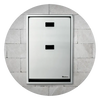Universal changing tables (also known as adult changing tables) and baby changing stations each play important – but distinctly different – roles in creating inclusive facilities that ensure safe, sanitary, dignified restroom access for all. As public awareness of accessibility and inclusion move to the forefront – and regulations increasingly reflect this prominence – it’s more essential than ever that public facilities provide comprehensive amenities that cater to patrons with a wide variety of needs and abilities.
Understanding the differences between these two types of changing stations and why businesses should offer both will significantly enhance the user experience, and goes a long way in promoting a welcoming and accessible environment for everyone.
Universal changing tables: Inclusive for people of all ages and abilities
Universal changing tables are designed to accommodate individuals with disabilities and their caregivers. They are longer and more robust than traditional baby changing stations, and have features that specifically cater to the diverse needs of individuals with disabilities, such as powered height adjustability.
According to the leading advocacy organization Changing Spaces USA, a universal changing table should be:
- Powered and Height-Adjustable to ensure easy loading and unloading for caregivers
- At least 70 inches long and at least 30 inches wide to comfortably accommodate adults of all sizes
- Possessing a side rail that can fold up and down, and locks into place
As an added bonus, easy installation ensures that facilities can upgrade or retrofit their facilities with minimal cost and manpower (not always a given with robust pieces of equipment like UCTs, which have unique demands beyond traditional ADA requirements).
Why universal changing tables are important:
- Dignity and comfort: Can you imagine using a public restroom without a door? Did you know that many families unable to use standard accessible restrooms often have to change diapers on public restroom floors, or in the trunk of the car? This is why providing a private, comfortable space for personal care while in public is crucial for individuals with disabilities.
- Support for caregivers: Adjustable-height tables can ease the physical strain on caregivers, while also eliminating the stress of having to find a private, comfortable place for changing (see point above!).
- Inclusivity: Universal changing tables ensure that public spaces are accessible to everyone, promoting social inclusion and equality.
Baby changing stations: Essential for families with young children
Baby changing stations are specifically designed to provide a safe, sanitary, and comfortable surface for parents and caregivers to changing a baby’s diaper while at restaurants, shopping areas, zoos, or any other public place.
Key features to look for:
- Installation type: Consider the size and style of the restroom and determine whether a surface mounted or recessed mounted changing station is best.
- Included amenities: Diaper changing stations with built-in liner dispensers and bag hooks will provide more convenience and a better experience for parents.
- Safety features: The best baby changing stations have safety features like bacteria-resistant materials, contoured changing surfaces, and safety straps.
- Weight capacity: Changing stations should comfortably support the weight of a growing baby or toddler without compromising safety. At minimum, Foundations baby changing stations support up to 150 pounds of weight, although most models have a weight capacity of 250 pounds.
Why baby changing stations are important:
- Convenience: Commercial changing stations help parents and caregivers change diapers easily, making outings less stressful.
- Hygiene: Clean, designated spaces for diaper changes reduce the risk of contamination on counters.
- Accessibility: When installed in men’s, women’s, gender neutral, and family restrooms, baby changing stations promote gender equality by supporting all caregivers. The 2016 BABIES (Bathrooms Accessible in Every Situation) Act went a long way in making baby changing stations more widely available in public buildings, but even then the changes mainly applied to just women’s restrooms. In recent years much statewide legislation has gone further by mandating that male caregivers have equal access to changing tables, too. And groups like Squat for Change have created more awareness around the need for equal accessibility.
Why facilities should offer both types of changing stations
-
Comprehensive Inclusivity
Providing both universal changing tables and baby changing stations ensures that all needs are met for any patron. While baby changing stations are essential for people with young children, universal changing tables cater to individuals or all ages with disabilities, and their caregivers, to ensure that no one is left out. -
Enhanced User Experience
Offering a comprehensive range of facilities makes public spaces more welcoming and comfortable for everyone. Parents can confidently bring their children know there are adequate facilities, and individuals with disabilities can enjoy the same comfort and dignity. -
Promote Equality
Businesses demonstrate a commitment to equality by offering both types of changing stations. This approach acknowledges the diverse needs of the community, from parents and young children to individuals with disabilities and their caregivers.
-
Legal Compliance and Social Responsibility
Many states and locales are introducing or have already ratified legislation that mandates accessibility in public spaces. Installing both baby changing stations and universal changing stations helps ensure compliance with these laws while also reflecting a sense of social responsibility.
-
Positive Community Engagement
Facilities that invest in inclusive amenities foster goodwill and a positive image. Patrons appreciate businesses and public spaces that prioritize their needs, leading to increased loyalty and positive word-of-mouth.
Understanding the differences between baby changing stations and universal changing tables highlights the importance of making both available in public facilities. Baby changing stations are crucial for the convenience and hygiene of people with babies and young children, while universal changing tables ensure dignity and accessibility for individuals with disabilities and their caregivers. By offering both, businesses can create a truly inclusive environment that meets the diverse needs of all patrons, enhancing their overall experience and promoting a culture of equality and respect.





